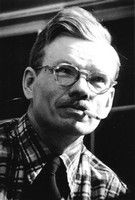Kenneth Stubbs |
 |
|
Stubbs Retrospective at PAAM: Legacy of Cubist EraProvincetown painter Kenneth Stubbs, who died 25 years ago, has left a legacy of fascinating work, highly personal but distinctly related to the era when the evolution of cubism was unfolding in America. His retrospective is on view at the Provincetown Art Association and Museum (PAAM) until October 27, curated by his wife Miriam who continues to live in their summer home in Provincetown. Born in 1907, Stubbs took to cubism with enthusiasm and inspiration, using it to convey his prime purpose, to "have the entire painting rather than the separate objects express the idea." His training was classical, however. The portait of Grace Powell, painted when he was only 28 and indicating his admiration for 15th century artist Piero della Francesca, is somber and moving. Here the young painter, perhaps in love with this strikingly beautiful woman, has conveyed the essence of both femininity and strength. Once could almost wish that his artistic inclination had allowed him to concentrate on portraiture as a career. But other muses called him. A mathematical side, intrigued by complex design and proportions, made him a natural student for the fresh ideas from Europe initiated and perpetuated by Cezanne, Juan Gris, Braque and Picasso. Where his mind worked ever-playfully with design, his heart was never far behind. Two "signature" colors -- a striking orange-red that often dominates a painting, and a cool, blue-grey that is often minimally used but as critical to the overall composition -- are keys to his work, representing his combined emotional and clinical approach to art. They can be found in almost every one of the paintings on exhibit. In "Artist and Model," an oil on canvas painted in 1947, the reds have become muted to almost rust color, but without the elegant blue patches, seemingly casual accents of cast shadows behind the artist, the painting would be lifeless. A small abstract, "Still Life with Fruit," is dominated by reds and oranges but balanced by only one section of the complimentary blue, indicating his recognition of the color's strength and subtle power. "The Dancers," painted in 1948, the year Stubbs married Miriam Margolies, receives its animation from his juxtaposition of line and color, with the reds and blues leading the eye in a zigzag pattern across the painted surface, as does "Basketball," painted in 1954. "The Dancers" was said humorously by his wife to have been created as a result of his "courting" aspirations. When he learned of her love of dancing, he took lessons to be able to convince her to date him, but seldom offered to take her dancing again once he had "caught his fish." Born in Georgia, Stubbs first studied at the Corcoran School of Art in Washington, D.C. after exhibiting considerable talent and interest in art as a child. His sister, Dorothy Stubbs Neyman, said he drew from an early age and knew that he would be an artist when other children his age were fantasizing about being train conductors and firemen. He heard of Provincetown from friends in Washington who had studied with E. Ambrose Webster, a proponent of cubism, and joined them and others such as Philip Malicoat, Bruce McKain and Eddie Euler who traveled from afar to learn new skills in what was then a charming New England fishing village and developing artists' colony. Like other artists who planted their roots in Provincetown, Stubbs was torn between his personal work and that of making a living. While in the Navy during World War II he learned techniques of animation and film production and continued to work as a consultant in animation for industrial and military training films long after the war. He helped raise a family of two children: Keith, who is now a computer expert, and Pamela, a social worker. He was very proud of his wife Miriam's career working for the implementation of federal programs for the handicapped, such as independent living. The exhibit has an attractive catalogue designed and produced by Provincetown painter Ewa Nogiec-Smith, with a review of Stubbs's work by Frank Getlein, art critic for the Washington Star and National Public Radio and Television, who has reviewed Stubbs's work since the 1960s. Commemorating Stubbs's artist career both as painter and teacher are two endowed fellowships in his name, at the Corcoran School of Art in Washington and Fine Arts Work Center in Provincetown, and an special fund at PAAM to assist with exhibitions of work by Provincetown artists. Joyce Johnson, The Cape Codder, October 8, 1991, pages 8-9
|
See also: Show Announcement Press Release Show Catalog Works Shown Frank Getlein Essay Cape Cod Times Review |